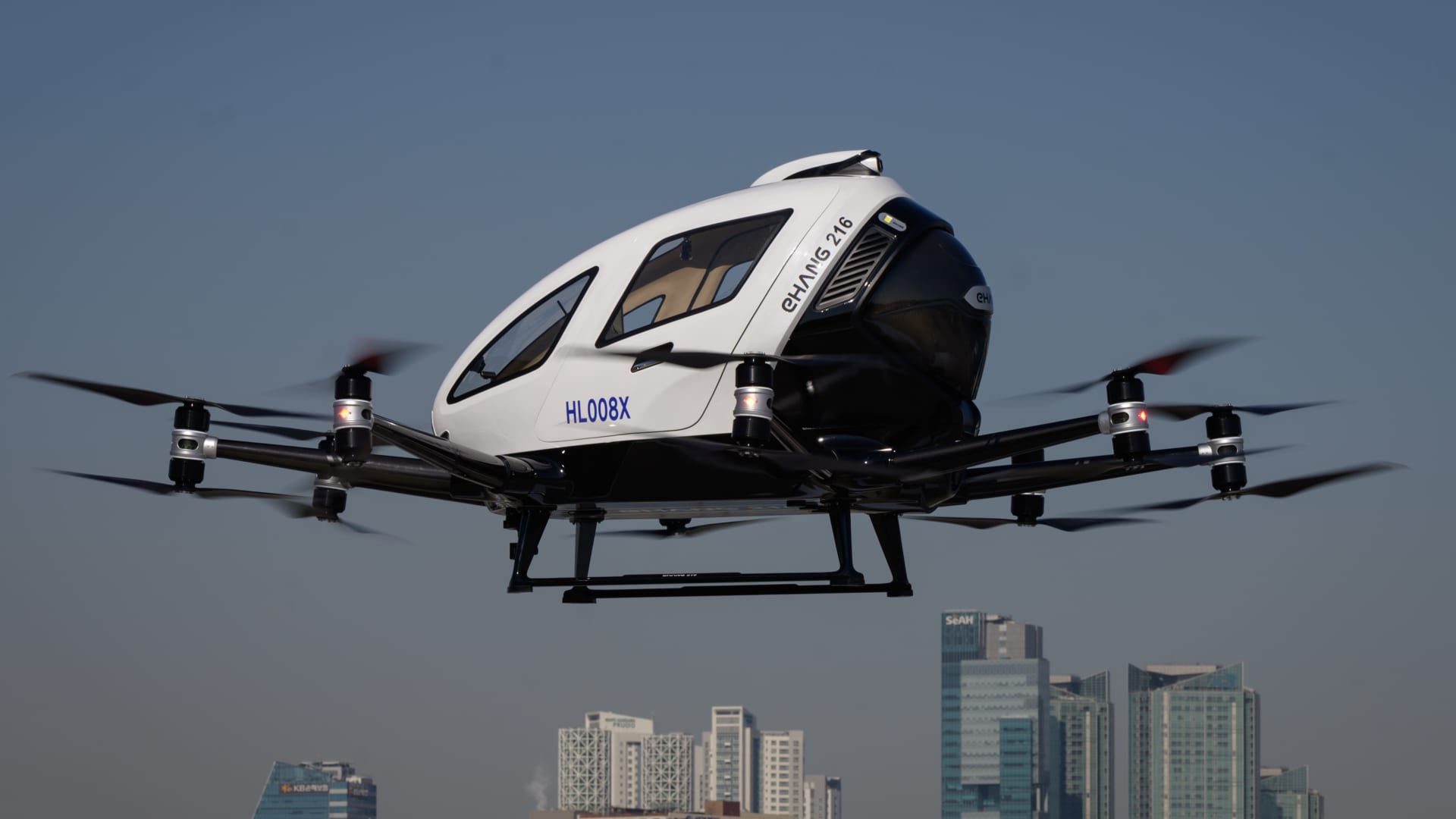An EHang all-electric Vertical Takeoff and Landing (eVTOL) two-passenger multicopter aircraft, performs an unmanned display flight at a Korean government event at Yeouido island in Seoul on November 11, 2020.
Ed Jones | Afp | Getty Images
BEIJING — Self-driving air taxis are one step closer to reality in China.
Guangzhou-based Ehang on Friday said it received an airworthiness “type certificate” from the Civil Aviation Administration of China for its fully autonomous drone, the EH216-S AAV, that carries two human passengers. The regulator is the equivalent of the Federal Aviation Administration in the U.S.
U.S.-listed Ehang claims it’s the first in the world to get such a certificate, which allows it to fly passenger-carrying autonomous electric vertical take-off and landing (eVTOL) aircraft in China.
The certificate will also significantly simplify the company’s ability to get similar certificates for commercial operation in the U.S., Europe and Southeast Asia, CEO Huazhi Hu told CNBC in a video conference interview.
“Next year we should start to expand overseas,” he said, noting those regulators still need to establish a process for mutual regulation of the Chinese airworthiness certification. That’s according to a CNBC translation of his Mandarin-language remarks.
Ehang shares have nearly doubled in price this year, before trading was temporarily halted Monday “in anticipation of an upcoming announcement concerning a very significant development regarding its business operations.” Trading was set to resume Friday.
The company has a market capitalization of about $1 billion.
Global regulatory action
The U.S. FAA in July released a plan that provides a path toward allowing similar autonomous flying vehicles, but initially still requires pilots to sit on board.
California-based Joby Aviation, one of the leading industry players in the U.S., announced earlier this month it expanded its flight test program from remote piloting to include a pilot on board — but it didn’t mention any passengers. Joby has a contract with the U.S. Air Force the company claims is worth up to $131 million.
Regulators in China have been paving the way for autonomous flying vehicles to gain certification. In June, China released new rules for unmanned aircraft flight — vehicles without a pilot on board. It is set to take effect Jan. 1, 2024.
Hu said Ehang is still evaluating which city in China the company will launch its first air taxi passenger flight in, and declined to share a specific date. Hu is also Ehang’s founder and chairman of the board of directors.
He noted that China is the fastest-growing and largest market — with the biggest demand — for such flying vehicles.
In the second quarter, Ehang said it set up a joint venture with Shenzhen-listed Xiyu Tourism and delivered five EH216-S units. The venture aims to develop low-altitude tourism with at least 120 Ehang vehicles in the next five years, the company said.
Ehang said it has overseas pre-orders for more than 1,200 units, including from customers such as Japan AirX, Malaysian Aerotree and Indonesia’s Prestige.
Hu said the company would roll out deliveries rather than filling orders all at once given the industry is still in an early stage of development.
Still, he predicts that in about five years, air taxis will be a common sight in many cities.
Safety track record
Friday’s certification news comes as local Chinese governments, including in Beijing, have allowed fully driverless robotaxis on public streets, and in some cases charge fares to the public.
A significant difference between self-driving taxis and self-piloting drones is that while cars on the road must make turns at intersections, a drone flight is between two points in the air, Ehang’s CEO said.
Hu said Ehang started doing autonomous aerial flight testing in 2017. There were some vehicle incidents during the early experimentation period, he said, but no big accidents have occurred during subsequent tens of thousands of flights, including overseas.
“Whenever carrying humans, until now, we have maintained a very good safety track record,” he said.
